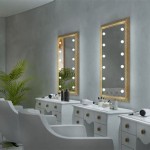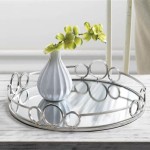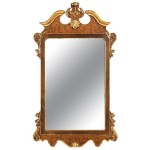How to Hang Up a Heavy Mirror Without Nails
Hanging a heavy mirror can be a daunting task, particularly when the desire is to avoid using nails. Nails can damage walls, leave unsightly holes, and may not provide sufficient support for heavier items. Fortunately, several alternative methods exist that allow for secure and aesthetically pleasing mirror hanging, all while preserving the integrity of the wall surface.
The key to successfully hanging a heavy mirror without nails lies in selecting the appropriate hanging mechanism and ensuring proper installation. This involves assessing the weight of the mirror, the type of wall, and choosing a solution that provides adequate holding power without compromising the wall's structural integrity. Careful planning and execution are essential for a safe and visually appealing result.
Understanding Weight Limits and Wall Types
Before attempting to hang a heavy mirror, it is crucial to accurately determine its weight. This information is often found on the mirror's packaging or manufacturer's website. If the weight is unknown, use a bathroom scale to obtain an accurate measurement. This measurement is fundamental in selecting the appropriate hanging hardware. Exceeding the weight limit of the chosen hardware can lead to the mirror falling and potentially causing damage or injury.
Different wall types require different approaches. Drywall, also known as gypsum board, is a common wall material found in many homes. It is relatively easy to damage and requires specific anchors to support significant weight. Plaster walls, which are often found in older homes, are more durable than drywall but can be prone to cracking if not handled carefully. Concrete or brick walls are the strongest options and can support considerable weight; however, they require specialized drilling and anchors.
Identifying the wall type is essential for selecting the proper hanging method. Attempting to use drywall anchors on a plaster wall, or vice versa, will likely result in failure. Understanding the characteristics of each wall type will ensure the selected hardware is appropriate and effective.
Exploring Nail-Free Hanging Options
Several nail-free hanging options are available, each with its own strengths and limitations. The choice depends on the mirror's weight, the wall type, and the desired aesthetic. Consider these options:
Heavy-Duty Adhesive Strips: These strips are designed to adhere strongly to both the mirror and the wall surface. They are a convenient option for lighter heavy mirrors. However, it is crucial to choose strips specifically rated for the mirror's weight and to follow the manufacturer's instructions carefully. Surface preparation is critical; the wall must be clean, dry, and free of dust or grease to ensure proper adhesion. These strips are not recommended for extremely heavy mirrors or walls with textured surfaces.
Adhesive Hooks Designed for Heavy Items: These hooks utilize a strong adhesive backing to attach to the wall. Similar to adhesive strips, they are relatively easy to install. Ensure the hooks are rated to hold the weight of the mirror with a safe weight allowance. Some adhesive hooks are designed for specific surfaces, so make sure to select ones compatible with your wall type.
Construction Adhesives: For heavier mirrors, construction adhesives can provide a more permanent and robust solution. These adhesives are applied directly to the back of the mirror and then pressed firmly against the wall. It is crucial to use a high-quality construction adhesive specifically designed for bonding to both the mirror's backing and the wall surface. Proper surface preparation is also essential. The mirror may need to be temporarily supported while the adhesive cures fully, which can take several hours or even days, depending on the product. This is generally not the best option to avoid damage as the mirror is essentially permanently attached, and removal can damage the mirror, the wall, or both.
Mirror Hanging Clips with Adhesive: These clips offer a more secure alternative to adhesive strips alone. The clips are attached to the wall using adhesive, and the mirror is then secured within the clips. This provides additional support and reduces the stress on the adhesive. Selecting clips with adjustable features allows for precise mirror placement and leveling. Again, weight rating and surface compatibility are crucial considerations.
Step-by-Step Installation Guidelines
Regardless of the chosen hanging method, proper installation is essential for ensuring the mirror's safety and stability. The following steps provide a general guideline for installing a heavy mirror without nails:
1. Gather Necessary Materials: Before beginning, gather all the required materials, including the chosen hanging hardware, a level, a measuring tape, a pencil, a clean cloth, and a cleaner suitable for the wall surface. Having all materials readily available will streamline the installation process.
2. Prepare the Wall Surface: Thoroughly clean the area where the mirror will be hung. Remove any dust, dirt, grease, or debris that could interfere with the adhesive bond. Use a cleaner appropriate for the wall surface and allow it to dry completely before proceeding.
3. Mark the Mirror's Position: Use a measuring tape and level to accurately mark the desired location for the mirror on the wall. This step is crucial for ensuring the mirror is hung straight and at the correct height. Measure the distance between the hanging hardware on the back of the mirror to ensure precise placement of the mounting points on the wall.
4. Install the Hanging Hardware: Carefully follow the manufacturer's instructions for installing the chosen hanging hardware. For adhesive strips or hooks, apply them firmly to the wall and allow them to cure for the recommended time before hanging the mirror. For construction adhesives, apply the adhesive to the back of the mirror in a consistent pattern and press the mirror firmly against the wall. Provide temporary support as needed.
5. Hang the Mirror: Once the hanging hardware is securely in place, carefully lift the mirror and position it onto the hardware. Ensure the mirror is properly aligned and securely attached. Double-check the level to ensure the mirror is hanging straight. For mirrors secured with clips, carefully slide the mirror into the clips and tighten any adjusting screws as needed.
6. Test the Stability: After hanging the mirror, gently test its stability by applying slight pressure to ensure it is securely attached to the wall. If any movement or instability is detected, re-evaluate the chosen hanging method and consider using a more robust solution.
7. Final Inspection: Perform a final inspection to ensure the mirror is level, securely attached, and aesthetically pleasing. Clean any fingerprints or smudges from the mirror surface to complete the process.
Proper planning, careful selection of hanging hardware, and meticulous installation are the keys to successfully hanging a heavy mirror without nails. By following these guidelines, individuals can achieve a safe and visually appealing result while preserving the integrity of their walls.
It is also important to periodically check the adhesion or stability of the hanging hardware, especially in environments with fluctuating temperatures or humidity levels. A preventative inspection can help to avoid any potential issues that might arise over time.

How To Hang A Mirror On Wall Without Nails

3 Simple Ways To Hang A Mirror On Wall Without Nails Wikihow

How To Hang Heavy Mirrors Frames Without Nails 3m

How To Hang Heavy Mirrors Frames Without Nails 3m

3 Simple Ways To Hang A Mirror On Wall Without Nails Wikihow

Hanging Heavy Objects Without Nails Tiktok Search
How To Hang A 100 Pound Mirror On Drywall Quora

How To Hang A Mirror On Wall Without Nails Guide For All Diyers

How To Hang A Heavy Mirror At Home

Hang Mirror Without Nail Or








